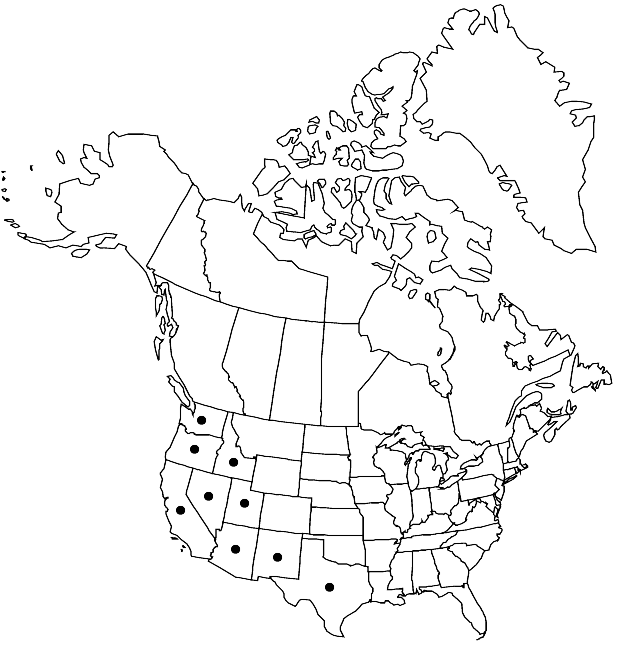Salix lasiolepis
Pl. Hartw., 335. 1857.
Shrubs or trees, 1.5–10 m, (sometimes forming clones by stem fragmentation). Stems: branches (sometimes flexible to highly brittle at base), yellowbrown to redbrown, not or weakly glaucous, glabrous, tomentose, pubescent (appearing dusty); branchlets yellowish, yellowbrown, or redbrown, sparsely to densely villous, tomentose, or velvety to glabrescent, (inner membranaceous bud-scale layer free, separating from outer layer). Leaves: stipules usually foliaceous, or rudimentary or absent on early ones, foliaceous on late ones, apex acute; petiole convex to flat, or shallowly grooved adaxially, 3–16 mm, tomentose or velvety adaxially; largest medial blade lorate, narrowly oblong, narrowly elliptic, oblanceolate, or obovate to broadly obovate, 36–125 × 6–32 mm, 1.9–9.6 times as long as wide, base cuneate or convex, margins slightly to strongly revolute, entire or remotely or irregularly serrate, sinuate, (glands submarginal or epilaminal), apex acute, acuminate, convex or rounded, abaxial surface glaucous, sparsely pubescent, moderately densely tomentose or woolly-tomentose, short or long-silky to glabrescent, hairs (white, sometimes also ferruginous), wavy, adaxial slightly or highly glossy, moderately densely tomentose or short-silky to glabrescent, (hairs white, sometimes also ferruginous); proximal blade margins entire or serrulate; juvenile blade color sometimes obscured by hairs, silky, tomentose or very densely woolly-tomentose abaxially, hairs white, sometimes ferruginous. Catkins flowering before or just before leaves emerge; staminate slender or stout, 18–88 × 5–15 mm, flowering branchlet 0–5 mm; pistillate densely flowered, slender or stout, 18–72 × 7–12 mm, flowering branchlet 0–6 mm; floral bract 1–2.4 mm, apex broadly rounded, abaxially hairy, hairs straight or wavy. Staminate flowers: adaxial nectary narrowly oblong, oblong, or ovate, 0.5–1.2 mm; filaments distinct or connate less than 1/2 their lengths; anthers purple turning yellow, ellipsoid or shortly cylindrical, 0.4–0.7 mm. Pistillate flowers: adaxial nectary oblong to flask-shaped, 0.2–1.1 mm; stipe 1–1.7 mm; ovary pyriform, beak slightly bulged below styles; ovules 10–18 per ovary; styles (sometimes slightly distinct distally), 0.1–0.6 mm; stigmas flat, abaxially non-papillate with rounded or pointed tip, or 2 plump lobes, 0.1–0.3 mm. Capsules 2.5–5.5 mm. 2n = 76.
Phenology: Flowering mid Jan-mid Jun.
Habitat: Streamshores, marshes, meadows, springs, coastal headlands, rocky bluffs, sand dunes, salt marshes, silty, sandy, gravelly, or rocky substrates, dolomite
Elevation: 0-2800 m
Distribution

Ariz., Calif., Idaho, Nev., N.Mex., Oreg., Tex., Utah, Wash., Mexico (Baja California), Mexico (Chiapas), Mexico (Chihuahua), Mexico (Coahuila), Mexico (Durango), Mexico (San Luis Potosí), Mexico (Sonora)
Discussion
Salix lasiolepis is polymorphic. Variety bigelovii has been recognized in coastal California and Oregon (G. W. Argus 1993). It differs mainly in density of leaf indumentum and in having leaves tending to be slightly broader; it may be a coastal ecotype and is not formally recognized here.
Hybrids:
Salix lasiolepis forms natural hybrids with S. irrorata and S. breweri. Hybrids with S. hookeriana are suspected but unconfirmed. The distinctly serrate leaves in some specimens from Arizona and New Mexico may be part of the species variability, but could also be due to hybridization.
Selected References
None.
